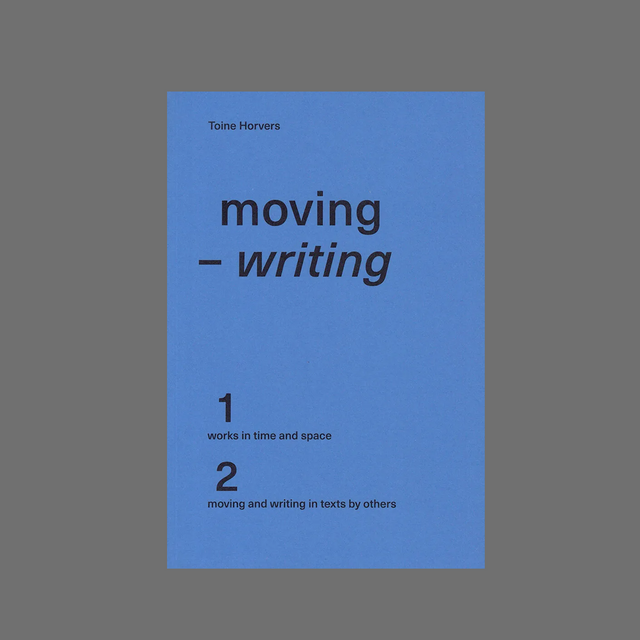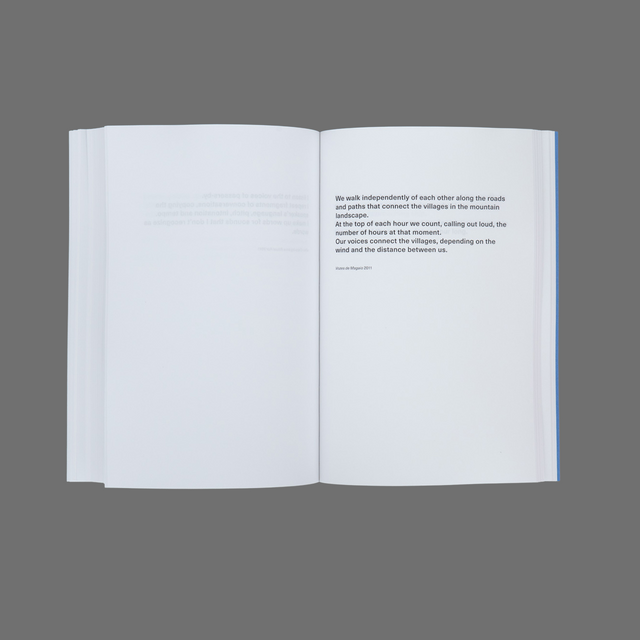

moving - writing
The book, that started four years ago as a possible form in which my ephemeral works could live on, gradually developed into an intensive writing project about movement and the imaginative power of language. It exists of two chapters:
1. works in space and time
Brief descriptions of my movement performances- and installations since 1979. Each of the 120 selected works has been translated in the most concise way possible into words and sentences.
Editing and text advice: Kathrin Wolkowicz / Dick van Teylingen
Translation: Simon Benson
2. moving and writing in texts by others
with contributions by: Marcus Bergner Hannes Böhringer Florian Cramer Jan Van Den Dobbelsteen Nell Donkers Tim Etchells Ger Groot Geert Koevoets Thomas Körtvelyessy Dom H. van der Laan Dick Raaijmakers Jan Laurens Siesling Sandra Smets Hans Stevens ieke Trinks Samuel Vriezen Ciel Werts - Emilie Gallier
Editorial advice: Kathrin Wolkowicz
Translations: Simon Benson, Maaike Trimbach, Samuel Vriezen, Helen Adkins, Vincent W.J. van Gerven Oei
Moving – Writing: rules/ restrictions /choices, arising during the act of writing
I describe everything as much as possible from my perspective as a performer/mover and in the present tense: all movements have at one time taken place (though sometimes never) and they could also take place here now.
I am giving an account of the movement as if I am performing it as the text is being read—in short sentences that follow the time/space progression of the movement (as if through language I am performing the movement again).
For works in which I was/am/will be not physically involved as a performer/mover, I describe the movement if possible in a single long sentence as an observer from distance—in both space and time—or I describe the movement as if I myself am the performer or a member of the performing group.
The first sentence of each text describes an action rather than a situation. The description starts from what, for me, is the essence of the work: the movement. One can read this as if the practical information about the situation is already known, and what is described is the most important fragment of a more extensive/general description.
For works that differ but are executed in a similar form or procedure, I have chosen the most tellable version. My movements start from an upright position, unless otherwise stated. I describe in-situ works as movements, without describing the situation as a source of inspiration. For that, I have in some cases made far-reaching changes compared to the original performance. In those cases, the title of the work is preceded by after. I avoid numbers, amounts, figures and dimensions.
For works consisting of an observing and a presenting part, I separate the two parts with a blank line. I also apply a blank line to works that consist of two parts for other reasons, for example, because they are separated in time or take place in different spaces. As far as possible, I use no adverbs. Exceptions are: gradually, slowly, evenly. I use no accents on letters or words.
I give no explanations or draw any conclusions. I avoid the words: thus, therefore, because, but, through, due to, etc., and punctuation marks like colons or semicolons. I avoid words that indicate a progression in time or refer back to something earlier in the text: as, first, then, after, still, also, again, until, next, etc., assuming that the order of the words and sentences conveys the time progression of the movement. Exceptions are while, simultaneously / at the same time for movements that occur at the same time. I avoid the words person or people. I also do not want to call those involved in the work performers, participants, volunteers, movers or executants, while persons or people feel impersonal/distant to me.
To avoid this problem, I often use we, even in cases where I am/was/will not be physically involved in the movement. We as an extension of I, the performer/mover. I have determined per work whether or not I am/was/will be physically involved.
I instead of he, or we instead of they, also makes the difference between describing the work as seen by an observer or by someone physically involved in the work, for example: we drum louder, instead of: the drumming gets louder. I also use we to avoid mentioning proper nouns. It also has to do with my starting point that in my work an audience or observer is not essential: the work exists/is/will be executed with or without an audience or observer.
I do not mention gender, except in one case where the difference in pitch between the female and male voice is relevant.
I use the same words and sentences for the same movements or elements thereof wherever possible.
I do: in the descriptions, words like can or try do not appear.
In line with how my work has developed—the growing intention to realise movements from my sense of space and time, rather than by using tools—I have left out all practical tools such as markers, clocks, mp3 players, speakers, and headphones in the descriptions. I describe the movement without explaining how it is practically/technically/organisationally realised. As far as possible, I do not mention objects, devices, props, materials or substances.
When referring to the place or setting of the performance, I name everything with the instead of a: despite the timeless and spaceless description, there is always a specific existing or having existed situation. So the building, instead of a (random) building. This manner of writing also makes clear that the descriptions are not intended as manuals, instructions, or recipes (one takes an apple) for the reader to perform the movements themselves, although they can be read that way—in fact, I only consider the description successful if it offers the reader the possibility to perform the movement themselves.
In the original Netherlands descriptions I prefer to use a Dutch word rather than one that derives from Latin, Greek, French, or English, often finding them more imaginative.
moving - writing
Toine Horvers
Suburban Foundation, 2017/2019
135 X 195mm, 192 pp; english
Softcover
Edition of 250
ISBN:9789083003849

Newsletter abonnieren
Informationen über Veranstaltungen, neue Künstler*innenbücher und Drucke direkt in Ihrem Posteingang.
einBuch.haus
Ein Projektraum und ein Verlag mit Sitz in Berlin, präsentiert internationale Künstler*innen und Grafiker*innen durch Ausstellungen, die das Konzept eines Buches in den dreidimensionalen Raum übertragen, und veröffentlicht diese Ausstellungen zudem in Buchform, um das Medium des Künstlerbuches hervorzuheben.
